标签:long 选择 目录 cli 也有 str out 步骤 append
原文地址:https://liugang594.iteye.com/blog/1328050
首先看看在OSGI中怎么启动内嵌的jetty容器。看下图:
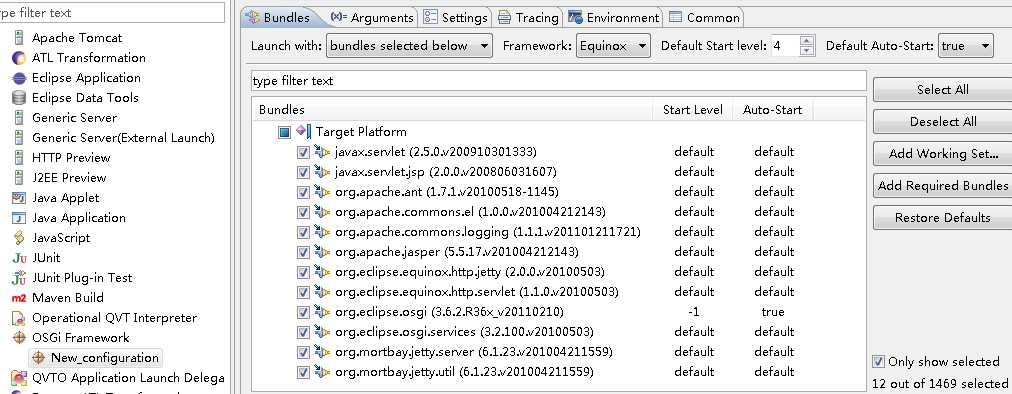
其实简单的只选中"org.eclipse.osgi"和"org.eclipse.equinox.http.jetty",然后点击"Add Required Bundles"即可。
默认的Jetty监听的端口为80,可又通过指定运行参数 org.osgi.service.http.port 来修改围住端口,例如要想使用8080端口,可又切换到 "Arguments"页:

完成配置又后,点运行即可:
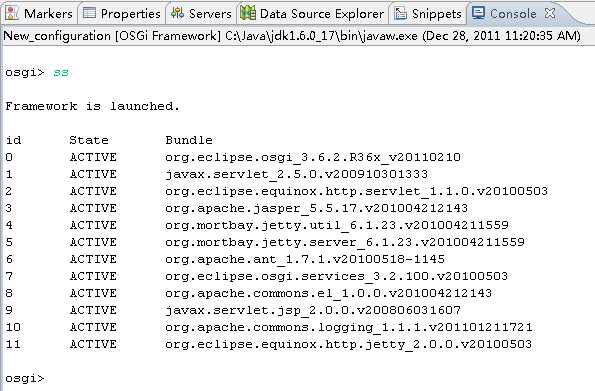
如果得到又上结果,说明运行成功,可以访问一下启动的jetty了:
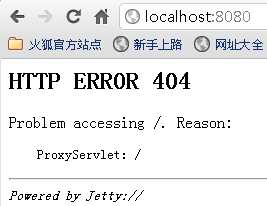
上面介绍了怎么在Eclipse的OSGI容器里启动Jetty服务,不过从结果看来,这个jetty里还没有什么内容。这一节我们就要加一点内容。
首先,先创建一个简单的osgi的bundle,过程如下:
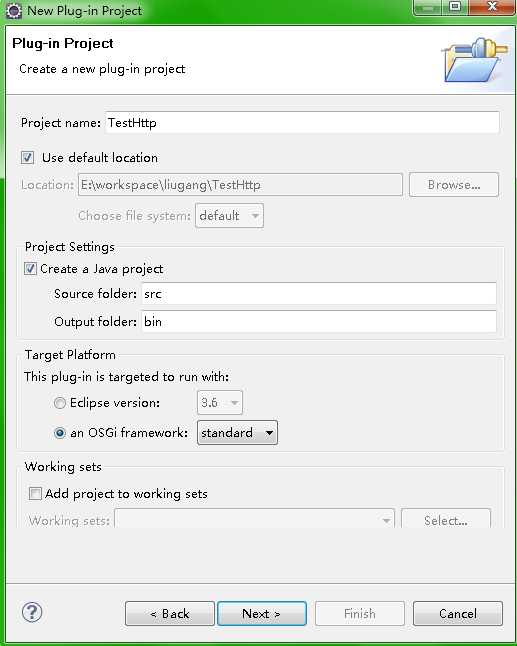
OK,一个基本OSGI的bundle project就创建完成。要结合使用http服务,需要添加以下依赖包:
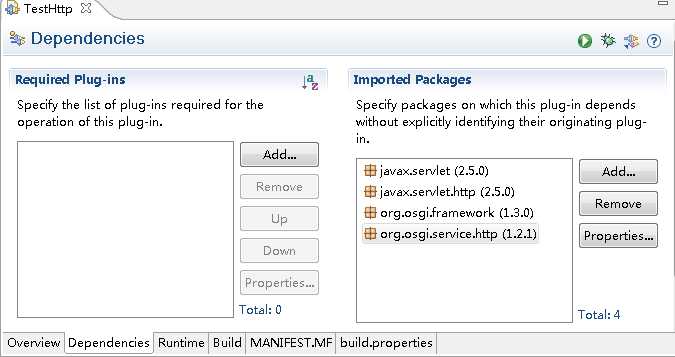
OK,配置部分就已经完成,下面就开始填写内容。
Eclipse内嵌有一个HttpService的实现,它位于包"org.osgi.service.http"下,一旦这个service所在的osgi bundle启动了,就会有一个内嵌的http容器被启动,这个service就会被注册,默认地址是http://localhost,端口为80,可以通过指定参数“org.osgi.service.http.port”参数在运行的时候修改默认端口(参见上上节)。(注:不应该试图自己去启动他那HttpService服务,那样可能达不到目的;另外应避免启动多个HttpService服务,又节省资源)
要想提供我们自己定义的http服务,就需要将我们的服务(servlet或者是其他html页面)注册到这个HttpService中去,这里主要是用到HttpService的两个注册方法:
用来注册诸如表态页面等等
用来注册servlet类
所以要想提供我自己的webservice实现,我们就需要:
我这里提供一个很简单的例子:一个页面,用户可又输入名字,然后点提交,将输入的信息提交到后台的servlet;servlet得到提交的名字,如果不为空,就将它打印出来,否则就提示用户需要输入一个名字。
提交页面的内容如下:
<html> <title>测试OSGI和HTTP</title> <meta http-equiv="Content-Type" content="text/html; charset=utf-8" /> <body> <form action="print" method="get"> 请输入名字: <input type="text" name="name" /> <input type="submit" value="提交" /> </form> </body> </html>
在src目录下他那一个目录web,然后将该文件保存为submit.html
package testhttp.servlets; import java.io.BufferedWriter; import java.io.IOException; import java.io.OutputStreamWriter; import javax.servlet.ServletException; import javax.servlet.http.HttpServlet; import javax.servlet.http.HttpServletRequest; import javax.servlet.http.HttpServletResponse; import org.osgi.framework.BundleContext; public class PrintNameServlet extends HttpServlet{ private static final long serialVersionUID = -9080875068147052401L; private BundleContext context; public PrintNameServlet(BundleContext context) { super(); this.context = context; } @Override protected void doPost(HttpServletRequest req, HttpServletResponse resp) throws ServletException, IOException { doGet(req, resp); } @Override protected void doGet(HttpServletRequest req, HttpServletResponse resp) throws ServletException, IOException { resp.setCharacterEncoding("UTF-8"); String name = req.getParameter("name"); System.out.println(name); String s = ""; if(name==null||"".equals(name.trim())){ s = "你没有输入名字"; }else{ s = "你输入的名字是:"+name.trim(); } StringBuilder sb = new StringBuilder(); sb.append("<html><title>Response</title><meta http-equiv=\"Content-Type\" content=\"text/html; charset=utf-8\" />"); sb.append("<body>"); sb.append(s); sb.append("</body></html>"); BufferedWriter bw = new BufferedWriter(new OutputStreamWriter(resp.getOutputStream(),"UTF-8")); bw.write(sb.toString()); bw.flush(); bw.close(); } }
页面也有了,servlet类也有了,下面就是将他们注册入HttpService里了。假如在我们的bundle一运行,这些http页面就可用,那么,我们可又在Activator里注册服务。
private HttpService service;
public void start(BundleContext bundleContext) throws Exception {
Activator.context = bundleContext;
ServiceReference serviceReference = bundleContext.getServiceReference(HttpService.class.getName());
service = (HttpService) bundleContext.getService(serviceReference);
}
这是一个例行公事般的步骤,一般取得一个特定服务的代码都可又这么实现。
有了HttpService对象,然后就是注册资源和servlet到这个HttpService对象:
public void start(BundleContext bundleContext) throws Exception {
Activator.context = bundleContext;
ServiceReference serviceReference = bundleContext.getServiceReference(HttpService.class.getName());
service = (HttpService) bundleContext.getService(serviceReference);
//register
HttpContext httpContext = service.createDefaultHttpContext();
service.registerResources("/osgi", "/web", httpContext); //设置别名,所有对"/osgi"映射到"web"目录
service.registerServlet("/osgi/print", new PrintNameServlet(bundleContext)
, null, httpContext); //设置servlet别名,‘/osgi/print"映射到servlet的实现
}
public void stop(BundleContext bundleContext) throws Exception { service.unregister("/osgi/print"); service.unregister("/osgi"); Activator.context = null; }
示例bundle已经准备好,最后就是启动这个bundle了,只需要在第一节的bundle列表中把这个bundle添加进去就可又了:
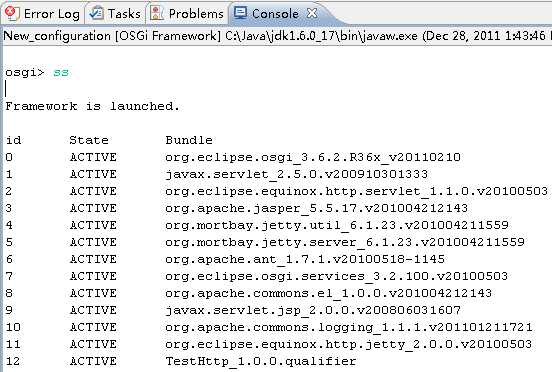
如果没有意外,访问 http://localhost:8080/osgi/submit.html
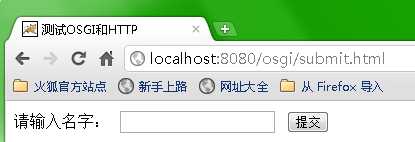
如果能看到这个页面,那基本就是成功了,输入"刘刚",提交后,返回结果为:
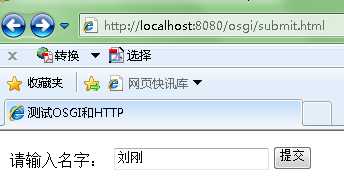
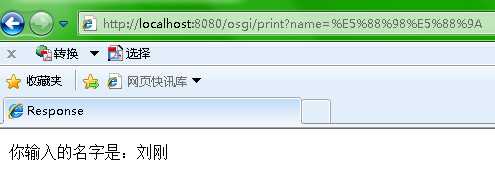
标签:long 选择 目录 cli 也有 str out 步骤 append
原文地址:https://www.cnblogs.com/dyh004/p/10647858.html